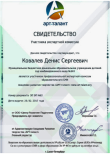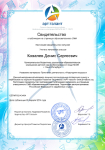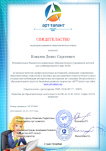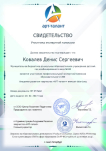Education in Great Britain (5)
Twelve million children attend about 40.000 schools in Britain. Education in Great Britain is compulsory and free for all children between the ages of 5 and 16. There are many children who attend a nursery school from the age of 3, but it is not compulsory. In nursery schools they learn some elementary things such as numbers, colours, and letters. Apart from that, babies play, have lunch and sleep there. Whatever they do, there is always someone keeping an eye on them.
Compulsory education begins at the age of 5 when children go to primary school. Primary education lasts for 6 years. It is divided into two periods: infant schools (pupils from 5 to 7 years old) and junior schools (pupils from 7 to 11 years old). In infant schools children don't have real classes. They mostly play and learn through playing. It is the time when children just get acquainted with the classroom, the blackboard, desks and the teacher. But when pupils are 7, real studying begins. They don't already play so much as they did it in infant school. Now they have real classes, when they sit at desks, read, write and answer the teacher's questions.
Compulsory secondary education begins when children are 11 or 12 and lasts for 5 years. Secondary school is traditionally divided into 5 forms: a form to each year. Children study English, Mathematics, Science, History, Art, Geography, Music, a Foreign language and have lessons of Physical training. Religious education is also provided. English, Mathematics and Science are called "core" subjects. At the age of 7,11 and 14 pupils take examinations in the core subjects.
There are 3 types of state secondary schools in Great Britain. They are:
comprehensive schools, which take pupils of all abilities without exams. In such schools pupils are often put into certain sets or groups, which are formed according to their abilities for technical or humanitarian subjects. Almost all senior pupils (around 90 per cent) go there;
grammar schools, which give secondary education of a very high standard. Entrance is based on the test of ability, usually at 11. Grammar schools are single sexed schools;
modern schools, which don't prepare pupils for universities. Education in such schools gives good prospects for practical jobs.
After five years of secondary education, at the age of 16, pupils take the General Certificate of Secondary Education (GCSE) examination. When they are in the third or in the forth form, they begin to choose their exam subjects and prepare for them.
After finishing the fifth form pupils can make their choice: they may either leave school and go to a Further Education College or continue their education in the sixth form. Those who stay at school after GCSE, study for 2 more years for "A' (Advanced) Level Exams in two or three subjects which is necessary to get a place at one of British universities.
There are also about 500 private schools in Great Britain. Most of these schools are boarding ones, where children live as well as study. Education in such schools is very expensive, that's why only 5 per cent of schoolchildren attend them. Private schools are also called preparatory (for children up to 13 years old) and public schools (for pupils from 13 to 18 years old). Any pupil can enter the best university of the country after leaving this school. The most famous British public schools are Eton, Harrow and Winchester.
After leaving secondary school young people can apply to a university, a polytechnic or a college of further education.
There are 126 universities in Britain. They are divided into 5 types:
The Old ones, which were founded before the 19th century, such as Oxford and Cambridge;
The Red Brick, which were founded in the 19th or 20th century;
The Plate Glass, which were founded in 1960s;
The Open University It is the only university offering extramural education. Students learn subjects at home and then post ready exercises off to their tutors for marking;
The New ones. They are former polytechnic academies and colleges.
The best universities, in view of "The Times" and "The Guardian", are The University of Oxford,
The University of Cambridge, London School of Economics, London Imperial College, London University College.
Universities usually select students basing on their А-level results and an interview.
After three years of study a university graduate get the Degree of a Bachelor of Arts, Science or Engineering. Many students then continue their studies for a Master's Degree and then a Doctor's Degree (PhD).
Перевод на русский язык Школа в России
Наанглийскомязыке
School In Russia
School system in Russia is a bit different from that accepted in other countries, but there is a lot in common too. Each city, town or even a village can boast having at least one or two schools. Some large Russian cities • have more than thousand schools. There can be state institutions and private ones. In my opinion, the more possibilities for studying we have - the better. Children’s education in Russia starts even before the primary school. At the age of two they normally attend the kindergarten. At this stage they learn how to interact with other kids and how to do some elementary things, such as drawing, participating in board games, writing their names, counting to ten, etc. When children turn six or seven they go to the primary school, where they learn the basics of reading, writing and counting. At the age of eleven-twelve they transfer to the secondary level. At some private institutions children pass certain tests. If they pass them successfully they are allowed to join the secondary school, where they study more complex subjects. Among them I can list Geography, History, Algebra, Geometry, Social Studies, Foreign Languages, etc. At some secondary schools they study Ecology, Home Economy, Computer Graphics and other subjects, which can be of use in modern life. At the age of fourteen or fifteen children should pass some exams to transfer to high school or college. Those, who graduate from high school, can enter the university they chose. Thisstepdefinesalltheirfurtherlifeandcareer.
Школьная система в России немного отличается от той, что принята в других странах, но и общие черты тоже есть. Каждый большой и маленький город, или даже село могут похвастать наличием, по меньшей мере, одной или двумя школами. В некоторых крупных российских городах бывает более одной тысячи школ. Причем учебные заведения могут быть как государственными, так и частными. На мой взгляд, чем больше возможностей для обучения, тем лучше. Образование детей в России начинается еще до начальной школы. В возрасте двух лет они обычно посещают детский сад. На этом этапе они учатся взаимодействовать с другими детьми, делать некоторые элементарные вещи, например, рисовать, участвовать в настольных играх, писать свои имена, считать до десяти и т.д. Когда детям исполняется шесть или семь лет они отправляются в начальную школу, где изучают основы чтения, письма и счета. В возрасте одиннадцати-двенадцати лет они переходят на второй уровень. В некоторых частных учреждениях дети проходят для этого определенные тесты. Если они их успешно сдают, то могут пройти в среднюю школу, где будут изучать более сложные предметы. Среди них я могу перечислить географию, историю, алгебру, геометрию, обществознание, иностранные языки и т.д. В некоторых средних школах они изучают экологию, домоводство, компьютерную графику и другие предметы, кбторые могут пригодиться в современной жизни. В возрасте четырнадцати или пятнадцати лет дети сдают несколько экзаменов, чтобы поступить в старшие классы или в колледж. Те, кто окончили старшие классы, могут поступать в университет, который заранее выбрали. Этот шаг определяет всю их дальнейшую жизнь и карьеру,



